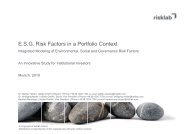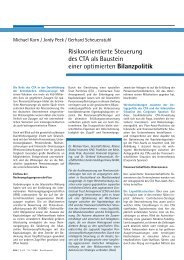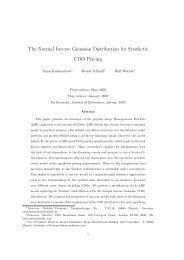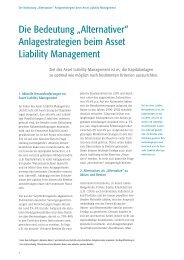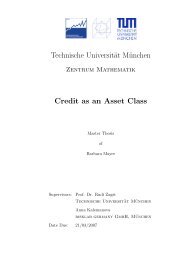Technical University Munich Commodities as an Asset Class - risklab
Technical University Munich Commodities as an Asset Class - risklab
Technical University Munich Commodities as an Asset Class - risklab
You also want an ePaper? Increase the reach of your titles
YUMPU automatically turns print PDFs into web optimized ePapers that Google loves.
2.1 The different Commodity Types<br />
terms of <strong>an</strong>other countries currency. 4 Exch<strong>an</strong>ge rates are determined by incomes<br />
<strong>an</strong>d relative prices. <strong>Commodities</strong>, <strong>as</strong> real <strong>as</strong>sets, typically rise in price when the<br />
currency in which they are quoted depreciates in value <strong>an</strong>d although commodity<br />
markets grow globally, the main trading currency is still the US dollar. The US<br />
government h<strong>as</strong> built up a m<strong>as</strong>sive account deficit which is caused by imports outweighting<br />
exports. Higher imports th<strong>an</strong> exports cause <strong>an</strong> over supply in US dollar<br />
<strong>an</strong>d <strong>an</strong> over dem<strong>an</strong>d of foreign currency what weakens the value of the US dollar<br />
<strong>an</strong>d rises commodity prices.<br />
The introductory words uncover the major characteristics in commodity markets.<br />
The prices are driven by current <strong>an</strong>d expected future supply <strong>an</strong>d dem<strong>an</strong>d equilibriums.<br />
In Section 2.1 we will give a more detailed inside into the three major<br />
commodity groups energy, metals <strong>an</strong>d agricultures. It will become clear that the<br />
single elements of the groups follow their own risk factors although technological<br />
improvements enable substitutions. Because our main purpose is the <strong>an</strong>alysis of investable<br />
commodities we only include commodities that are traded at <strong>an</strong> exch<strong>an</strong>ge.<br />
When it comes to commodity investment, we need to underst<strong>an</strong>d the interaction of<br />
the different market particip<strong>an</strong>ts <strong>an</strong>d their trading motivations. This is discussed in<br />
Section 2.2. We close the overview of commodity markets with a brief summary of<br />
the different fin<strong>an</strong>cial vehicles enabling commodity investments in Section 2.3.<br />
2.1 The different Commodity Types<br />
Commodity markets are divided into three major groups: energy, metals <strong>an</strong>d agricultures<br />
<strong>as</strong> it c<strong>an</strong> be seen in Figure 2.1. Into the energy group account all products<br />
which c<strong>an</strong> be used to produce electricity, heat <strong>an</strong>d fuel. While coal drove the industrialization<br />
through the 18th <strong>an</strong>d 19th century, the commodity w<strong>as</strong> substituted by<br />
oil since the beginning of the l<strong>as</strong>t century. Today’s high price environment drives a<br />
new substitution wave into alternative energy sources. Because crude oil <strong>an</strong>d natural<br />
g<strong>as</strong> account for around 60% of word’s energy usage we will discuss them in<br />
Section 2.1.1 more detailed.<br />
Appendix B.1 <strong>an</strong>d B.2 will further give a detailed <strong>an</strong>alysis of crude oil downstream<br />
products heating oil <strong>an</strong>d g<strong>as</strong>oline. It is provided to get a deeper underst<strong>an</strong>ding of<br />
the use impact, oil h<strong>as</strong> to our daily life.<br />
4 See [Sawyer Sprinkle 2003].<br />
5



